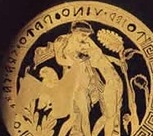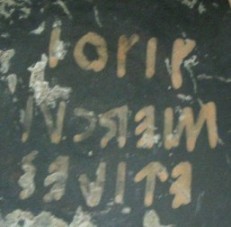Red-Figured Kylix with painted motto

Source: Fonte
Falerii Veteres (Civita Castellana), Faliscan Red-Figured kylix with representation of Dionysus and Ariadne embracing (second half of 4th century BCE).
The inscription is painted around the inner tondo, in a specific space left free from the meander decoration:
foied . uino . pafo . cra . care[f]o
“today I will drink wine, tomorrow I will miss (it)”
A second kylix, identical to this, presents an almost matching inscription, only different for the verbal stem: pipafo instead of pafo.
The motto encourages the reader to enjoy the current moment (a precocious carpe diem); it is valuable for the opportunity of comparing it to Latin, especially because of the preservation of the future tense, only rarely used in epigraphic texts.
Note the variation f/h that changes even the form of the demonstrative foied = ho-(d)ie, “today” (literally “in this day”).
The verb, corresponding to Classical Latin bibo, presents in the Faliscan version an unvoiced labial stop, confirming the absence of B in Faliscan epigraphy.
The ending -fo of the future tense tallies with Latin -bo, with a different outcome of the inner middle aspirate stop (< *-bho).
Votive dedication by the Aediles to Titus Mercurius

Source: Fonte
Falerii Veteres (Civita Castellana), Sanctuary of Sassi Caduti (end of the 4th century BCE).
titoi | mercui | efiles
The name of the deity (in dative case Mercui, corresponding to Latin Mercurius) is preceded by the term Titoi, also in dative, which can be probably translated into Classical Latin as genius, “genie”, with reference to the generative capability.
The authors of the dedication are the magistrates efiles, corresponding to Latin aediles according to Faliscan phonetics, with monophthongation of the first vowel and different outcome of the inner middle aspirate stop.